Immunoenhancing Effects of Jeju Agastache rugosa Extracts on NK Cell Activity and Lymphocyte Proliferation in Cyclophosphamide-Induced Immunosuppression
Abstract
1. Introduction
2. Results
2.1. Effect of ARE-W and ARE-E on Body Weight Changes in Mice
2.2. Effect of ARE-W and ARE-E on Spleen Weight Changes in Mice
2.3. Effect of Oral Administration of ARE-W and ARE-E on NK Cell Activity in Mice
2.4. Effect of Oral Administration of ARE-W and ARE-E on IFN-γ Production in Mice
2.5. Effect of Oral Administration of ARE-W and ARE-E on Splenic Lymphocyte Proliferation in Mice
3. Discussion
4. Materials and Methods
4.1. Preparation of Agastache rugosa Extract
4.2. Experimental Animals
4.3. Reagents
4.4. Evaluation of Immune-Restoring Effects of Jeju ARE in Cyclophosphamide-Treated Mice
4.5. Body Weight and Spleen Index Measurement
4.6. Analysis of Tumor Cell Cytotoxicity by NK Cells
4.7. Analysis of IFN-γ Production by NK Cells
4.8. Analysis of Splenic Lymphocyte Proliferation
4.9. Statistical Analysis
5. Conclusions
Supplementary Materials
Author Contributions
Funding
Institutional Review Board Statement
Informed Consent Statement
Data Availability Statement
Acknowledgments
Conflicts of Interest
Abbreviations
| CPA | Cyclophosphamide |
| NK | Natural killer |
| IFN-γ | Interferon-gamma |
| ARE-W | Hot water extract |
| ARE-E | Ethanol extract |
| Con A | Concanavalin A |
| i.p. | Intraperitoneal |
| LDH | Lactate dehydrogenase |
| SD | Standard deviation |
References
- Iwasaki, A.; Medzhitov, R. Control of adaptive immunity by the innate immune system. Nat. Immunol. 2015, 16, 343–353. [Google Scholar] [CrossRef]
- Warrington, R.; Watson, W.; Kim, H.L.; Antonetti, F.R. An introduction to immunology and immunopathology. Allergy, Asthma Clin. Immunol. 2011, 7 (Suppl. 1). [Google Scholar] [CrossRef]
- Kuchroo, V.K.; Ohashi, P.S.; Sartor, R.B.; Vinuesa, C.G. Dysregulation of immune homeostasis in autoimmune diseases. Nat. Med. 2012, 18, 42–47. [Google Scholar] [CrossRef] [PubMed]
- Dunn, G.P.; Bruce, A.T.; Ikeda, H.; Old, L.J.; Schreiber, R.D. Cancer immunoediting: From immunosurveillance to tumor escape. Nat. Immunol. 2002, 3, 991–998. [Google Scholar] [CrossRef] [PubMed]
- Dhabhar, F.S. Effects of stress on immune function: The good, the bad, and the beautiful. Immunol. Res. 2014, 58, 193–210. [Google Scholar] [CrossRef]
- Singh, J.A.; Wells, G.A. The benefits and harms of systemic immunosuppressive agents in rheumatoid arthritis. Rheumatology 2011, 50, 2273–2300. [Google Scholar]
- Youssef, J.; Novosad, S.A.; Winthrop, K.L. Infection risk and safety of corticosteroid use. Rheum. Dis. Clin. North Am. 2016, 42, 157–176. [Google Scholar] [CrossRef]
- Mahajan, S.G.; Mehta, A.A. Immunomodulators: A pharmacological review. Asian J. Pharm. Clin. Res. 2011, 4, 45–54. [Google Scholar]
- Shakya, A.K. Medicinal plants: Future source of new drugs. Int. J. Herb. Med. 2016, 4, 59–64. [Google Scholar]
- Gao, S.; Hong, H.; Zhang, C.; Wang, K.; Zhang, B.; Han, Q.-A.; Liu, H.; Luo, Y. Immunomodulatory effects of collagen hydrolysates from yak (Bos grunniens) bone on cyclophosphamide-induced immunosuppression in BALB/c mice. J. Funct. Foods 2019, 60, 103420. [Google Scholar] [CrossRef]
- Katahara, H.; Baba, K.; Nakajima, H.; Funasaka, C.; Kondoh, C.; Naito, Y.; Udagawa, H.; Shitara, K.; Sasaki, T.; Kawasaki, T.; et al. Cyclophosphamide for anticancer therapy-induced interstitial lung disease in the modern era: A retrospective cohort study. Front. Oncol. 2025, 15, 1567317. [Google Scholar] [CrossRef] [PubMed]
- Quan, X.-Y.; Chen, H.-T.; Liang, S.-Q.; Yang, C.; Yao, C.-W.; Xu, Y.-Z.; Liu, H.-F.; An, N.; Abdalla, S.S. Revisited cyclophosphamide in the treatment of lupus nephritis. BioMed Res. Int. 2022, 2022, 8345737. [Google Scholar] [CrossRef]
- Deng, J.; Zhong, Y.-F.; Wu, Y.-P.; Luo, Z.; Sun, Y.-M.; Wang, G.-E.; Kurihara, H.; Li, Y.-F.; He, R.-R. Carnosine attenuates cyclo-phosphamide-induced bone marrow suppression by reducing oxidative DNA damage. Redox Biol. 2018, 14, 1–6. [Google Scholar] [CrossRef] [PubMed]
- Rehman, M.U.; Tahir, M.; Ali, F.; Qamar, W.; Lateef, A.; Khan, R.; Quaiyoom, A.; Hamiza, O.O.; Sultana, S. Cyclophosphamide-induced nephrotoxicity, genotoxicity, and damage in kidney genomic DNA of Swiss albino mice: The protective effect of ellagic acid. Mol. Cell. Biochem. 2012, 365, 119–127. [Google Scholar] [CrossRef]
- Seo, H.; Kim, C.; Kim, M.-B.; Hwang, J.-K. Anti-photoaging effect of Korean mint (Agastache rugosa Kuntze) extract on UVB-irradiated human dermal fibroblasts. Prev. Nutr. Food Sci. 2019, 24, 442–448. [Google Scholar] [CrossRef]
- Desta, K.T.; Kim, G.S.; Kim, Y.H.; Lee, W.S.; Lee, S.J.; Jin, J.S.; Abd El-Aty, A.M.; Shin, H.C.; Shim, J.H.; Shin, S.C. The polyphenolic profiles and antioxidant effects of Agastache rugosa Kuntze (Banga) flower, leaf, stem and root. Biomed. Chromatogr. 2016, 30, 225–231. [Google Scholar] [CrossRef]
- Cao, P.; Xie, P.; Wang, X.; Wang, J.; Wei, J.; Kang, W.-Y. Chemical constituents and coagulation activity of Agastache rugosa. BMC Complement. Altern. Med. 2017, 17, 93. [Google Scholar] [CrossRef]
- Zielińska, S.; Matkowski, A. Phytochemistry and bioactivity of aromatic and medicinal plants from the genus Agastache (Lamiaceae). Phytochem. Rev. 2014, 13, 391–416. [Google Scholar] [CrossRef]
- Kim, H.K.; Lee, H.-K.; Shin, C.-G.; Huh, H. HIV integrase inhibitory activity of Agastache rugosa. Arch. Pharmacal Res. 1999, 22, 520–523. [Google Scholar] [CrossRef] [PubMed]
- Lim, H.-W.; Lee, Y.; Huang, Y.-H.; Yoon, J.-Y.; Lee, S.H.; Kim, K.; Lim, C.-J. Enhancement of skin antioxidant and anti-inflammatory potentials of Agastache rugosa leaf extract by probiotic bacterial fermentation in human epidermal keratinocytes. Microbiol. Biotechnol. Lett. 2017, 45, 35–42. [Google Scholar] [CrossRef]
- Yeo, H.J.; Kwon, M.J.; Han, S.Y.; Jeong, J.C.; Kim, C.Y.; Park, S.U.; Park, C.H. Effects of carbohydrates on rosmarinic acid production and in vitro antimicrobial activities in hairy root cultures of Agastache rugosa. Plants 2023, 12, 797. [Google Scholar] [CrossRef]
- Song, J.-H.; Nam, H.-H.; Park, I.; Yang, S.; Chun, J.M.; Seo, Y.-S.; Kim, H.-Y.; Moon, B.C.; Kang, S.; Moon, C.; et al. Comparative Morphology of Island and Inland Agastache rugosa and Their Gastroprotective Effects in EtOH/HCl-Induced Gastric Mucosal Gastritis. Planta Medica 2024, 90, 4–12. [Google Scholar] [CrossRef]
- Kang, S.; Lee, N.; Jung, B.; Jeong, H.; Moon, C.; Park, S.-I.; Yun, S.; Yim, T.; Oh, J.M.; Kim, J.-W.; et al. Anti-Amnesic Effect of Agastache rugosa on Scopolamine-Induced Memory Impairment in Mice. Pharmaceuticals 2024, 17, 1173. [Google Scholar] [CrossRef]
- Mah, A.Y.; Cooper, M.A. Metabolic regulation of natural killer cell IFN-γ production. Crit. Rev. Immunol. 2016, 36, 131–147. [Google Scholar] [CrossRef]
- Miller, J.S.; Lanier, L.L. Natural killer cells in cancer immunotherapy. Annu. Rev. Cancer Biol. 2019, 3, 77–103. [Google Scholar] [CrossRef]
- Sasidharan, S.; Chen, Y.; Saravanan, D.; Sundram, K.M.; Latha, L.Y. Extraction, isolation and characterization of bioactive compounds from plants’ extracts. Afr. J. Tradit. Complement. Altern. Med. 2011, 8, 1–10. [Google Scholar] [CrossRef] [PubMed]
- Fongang Fotsing Yannick, S.; Bankeu Kezetas Jean, J.; Gaber El-Saber, B.; Iftikhar, A.; Lenta Ndjakou, B. Extraction of Bioactive Compounds from Medicinal Plants and Herbs; IntechOpen: Rijeka, Croatia, 2021. [Google Scholar]
- Zhang, Q.-W.; Lin, L.-G.; Ye, W.-C. Techniques for extraction and isolation of natural products: A comprehensive review. Chin. Med. 2018, 13, 20. [Google Scholar] [CrossRef] [PubMed]
- Zebeaman, M.; Tadesse, M.G.; Bachheti, R.K.; Bachheti, A.; Gebeyhu, R.; Chaubey, K.K.; Li, M.H. Plants and plant-derived molecules as natural immunomodulators. BioMed Res. Int. 2023, 2023, 7711297. [Google Scholar] [CrossRef]
- Harun, N.H.; Septama, A.W.; Ahmad, W.A.N.W.; Suppian, R. Immunomodulatory effects and structure-activity relationship of botanical pentacyclic triterpenes: A review. Chin. Herb. Med. 2020, 12, 118–124. [Google Scholar] [CrossRef]
- Park, Y.-G.; Cho, J.-H.; Choi, J.; Ju, E.-M.; Adam, G.O.; Hwang, D.-I.; Lee, J.-H.; An, S.-Y.; Choi, H.-K.; Park, C.-B.; et al. Immunomodulatory effects of Curcuma longa L. and Carthamus tinctorius L. on RAW 264.7 macrophages and cyclophosphamide-induced immunosuppression C57BL/6 mouse models. J. Funct. Foods 2022, 91, 105000. [Google Scholar] [CrossRef]
- Kim, S.J.; Baek, S.H.; Kang, K.S.; Shin, M.S. Characterization of macrophage activation after treatment with poly-saccharides from ginseng according to heat processing. Appl. Biol. Chem. 2023, 66, 15. [Google Scholar] [CrossRef]
- Shin, M.-S.; Song, J.H.; Choi, P.; Lee, J.H.; Kim, S.-Y.; Shin, K.-S.; Ham, J.; Kang, K.S. Stimulation of innate immune function by Panax ginseng after heat processing. J. Agric. Food Chem. 2018, 66, 4652–4659. [Google Scholar] [CrossRef]
- Kim, H.I.; Kim, D.-S.; Jung, Y.; Sung, N.-Y.; Kim, M.; Han, I.-J.; Nho, E.Y.; Hong, J.H.; Lee, J.-K.; Boo, M.; et al. Immune-enhancing effect of Sargassum horneri on cyclophosphamide-induced immunosuppression in BALB/c mice and primary cultured splenocytes. Molecules 2022, 27, 8253. [Google Scholar] [CrossRef]
- Huang, J.-Q.; Pang, M.-R.; Li, G.-Y.; Wang, N.; Jin, L.; Zhang, Y. Alleviation of cyclophosphamide-induced immunosuppression in mice by naturally acetylated hemicellulose from bamboo shavings. Food Agric. Immunol. 2017, 28, 328–342. [Google Scholar] [CrossRef]
- Zhang, S.; Kohli, K.; Black, R.G.; Yao, L.; Spadinger, S.M.; He, Q.; Pillarisetty, V.G.; Cranmer, L.D.; Van Tine, B.A.; Yee, C.; et al. Systemic interferon-γ increases MHC class I expression and T-cell infiltration in cold tumors: Results of a phase 0 clinical trial. Cancer Immunol. Res. 2019, 7, 1237–1243. [Google Scholar] [CrossRef] [PubMed]
- Gao, J.; Shi, L.Z.; Zhao, H.; Chen, J.; Xiong, L.; He, Q.; Chen, T.; Roszik, J.; Bernatchez, C.; Woodman, S.E.; et al. Loss of IFN-γ pathway genes in tumor cells as a mechanism of resistance to anti-CTLA-4 therapy. Cell 2016, 167, 397–404. [Google Scholar] [CrossRef]
- Kim, S.H.; Hong, J.H.; Yang, W.K.; Geum, J.H.; Kim, H.R.; Choi, S.Y.; Kang, Y.M.; An, H.J.; Lee, Y.C. Herbal Combinational Medication of Glycyrrhiza glabra, Agastache rugosa Containing Glycyrrhizic Acid, Tilianin Inhibits Neutrophilic Lung Inflammation by Affecting CXCL2, Interleukin-17/STAT3 Signal Pathways in a Murine Model of COPD. Nutrients 2020, 12, 926. [Google Scholar] [CrossRef] [PubMed]
- Hong, S.; Cha, K.H.; Kwon, D.Y.; Son, Y.J.; Kim, S.M.; Choi, J.-H.; Yoo, G.; Nho, C.W. Agastache rugosa ethanol extract suppresses bone loss via induction of osteoblast differentiation with alteration of gut microbiota. Phytomedicine 2021, 84, 153517. [Google Scholar] [CrossRef]
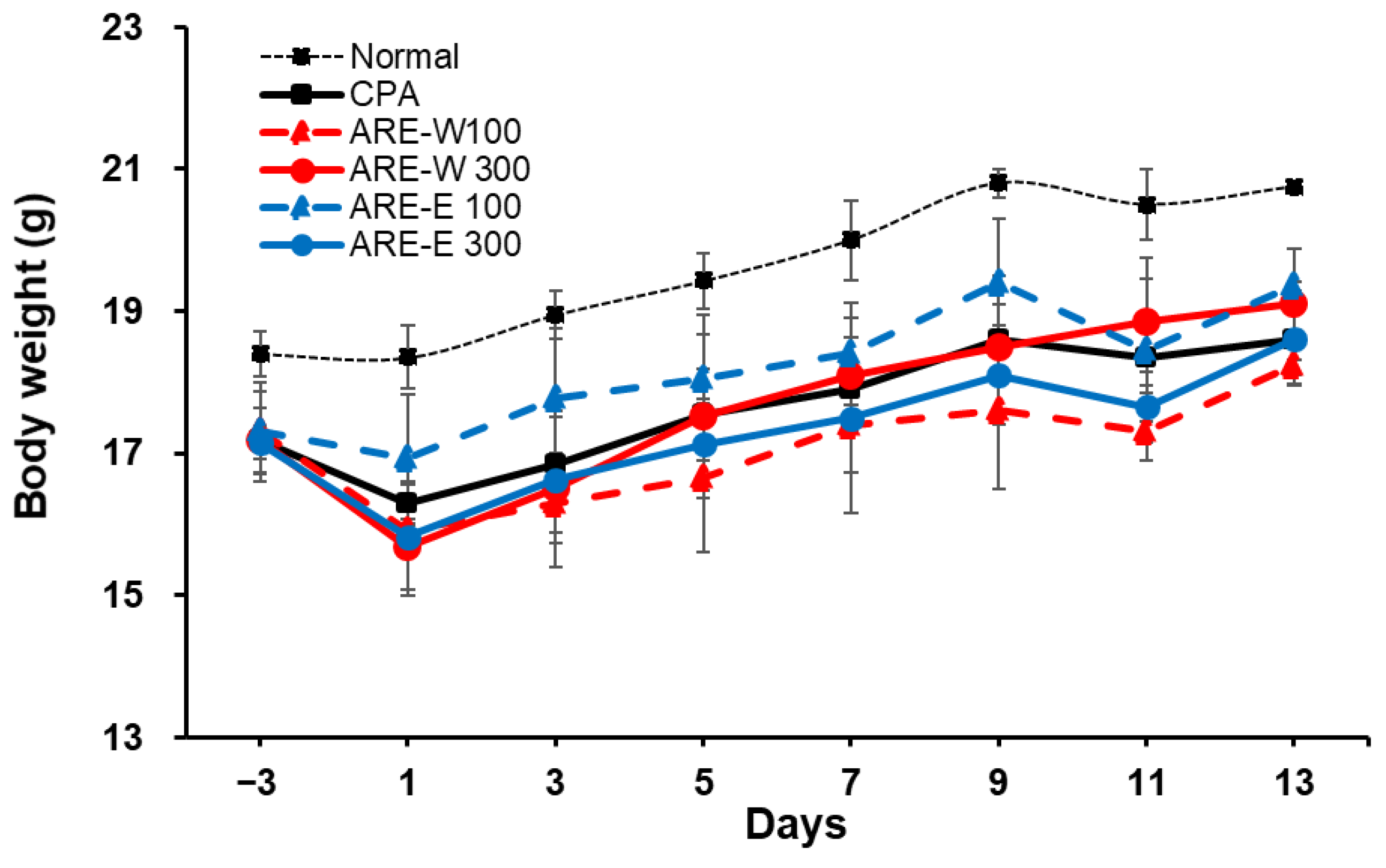
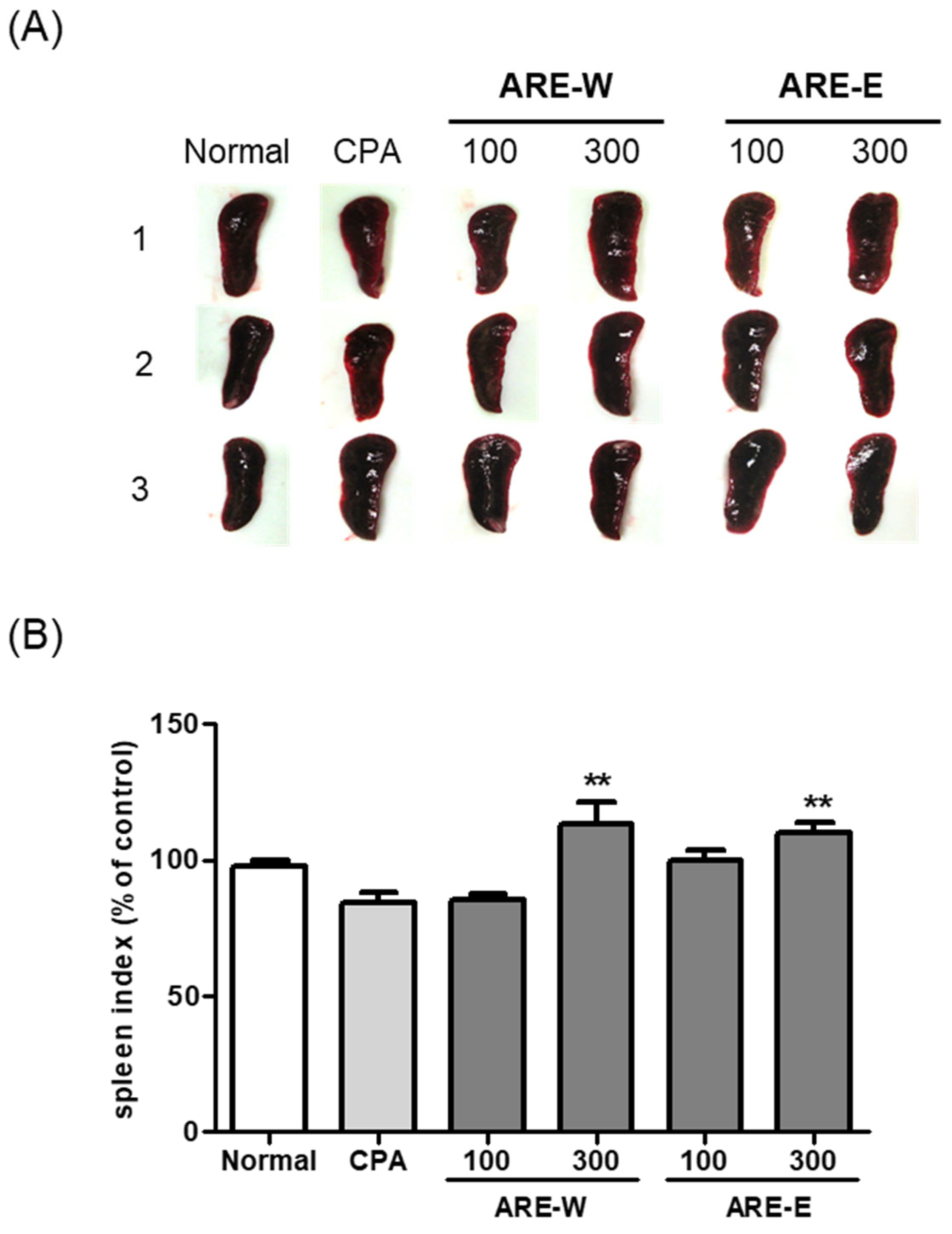
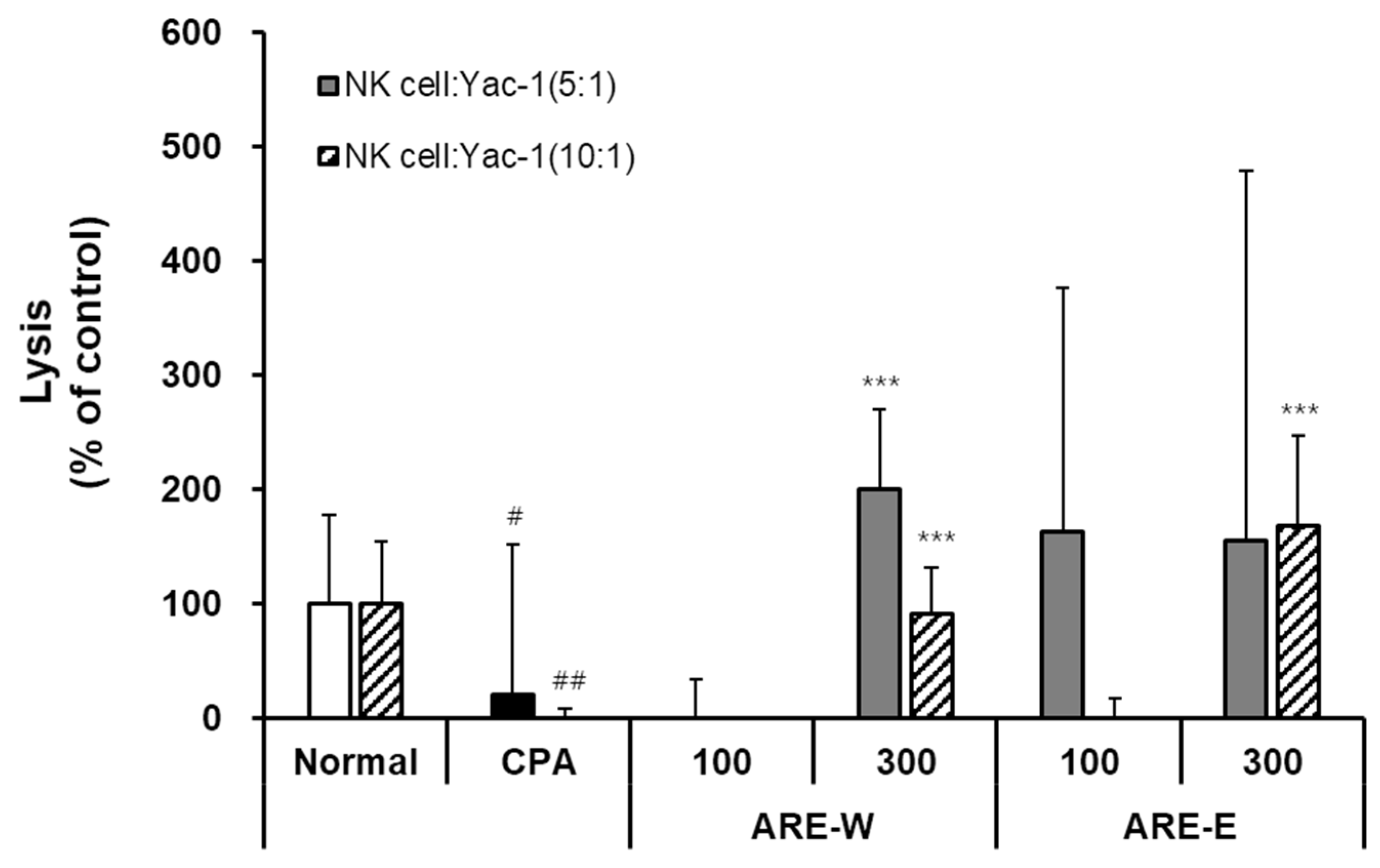
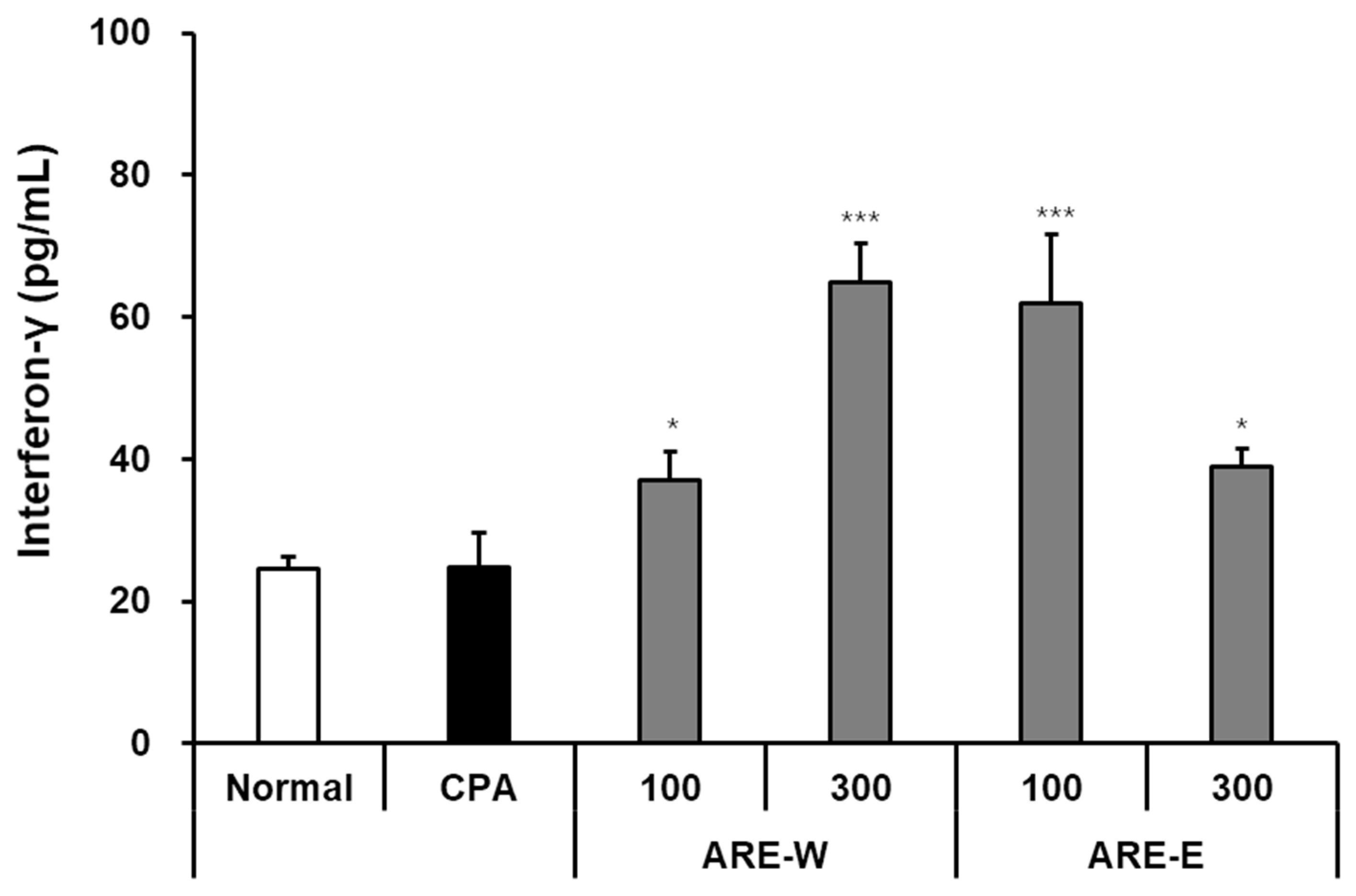
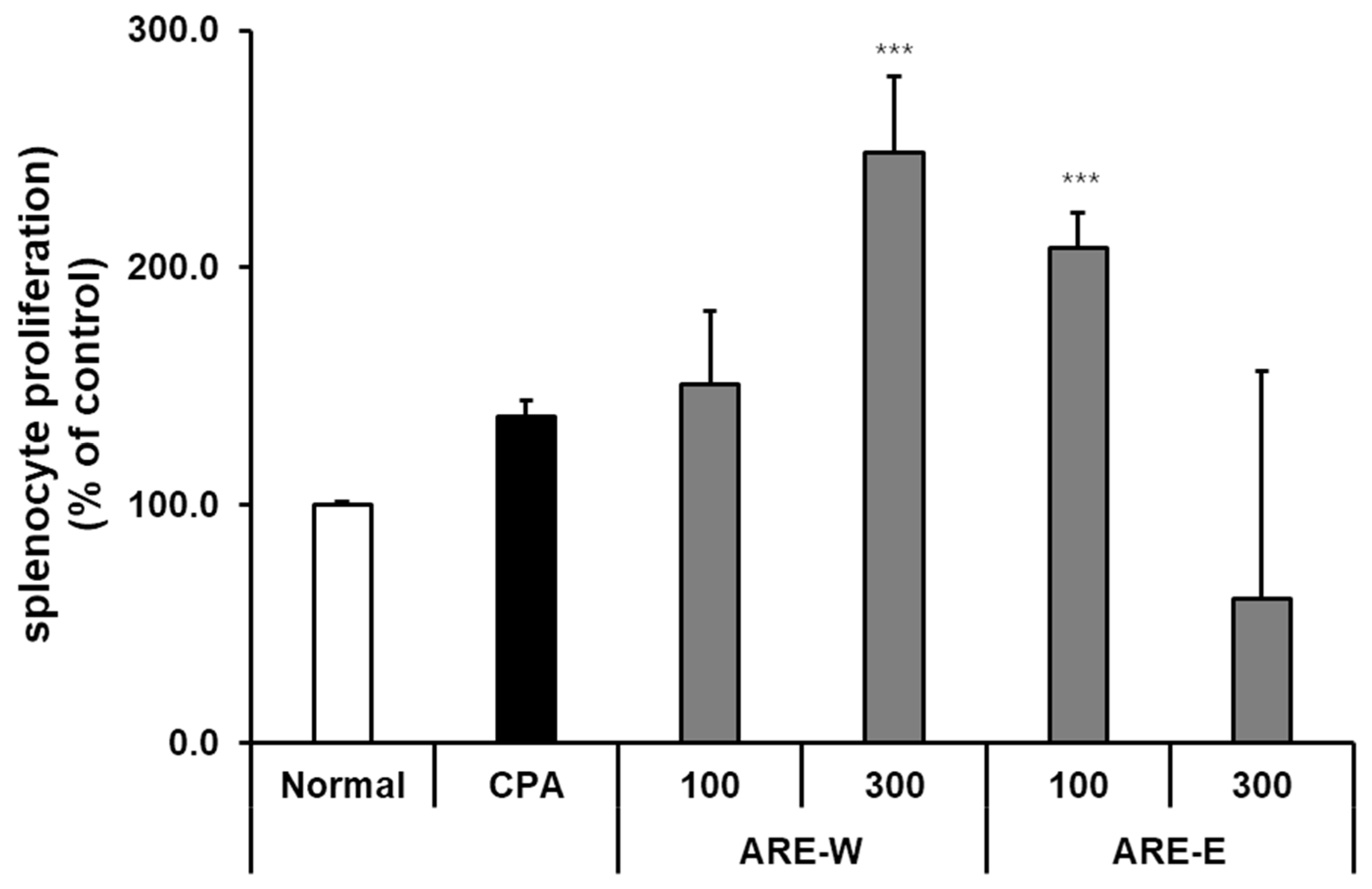
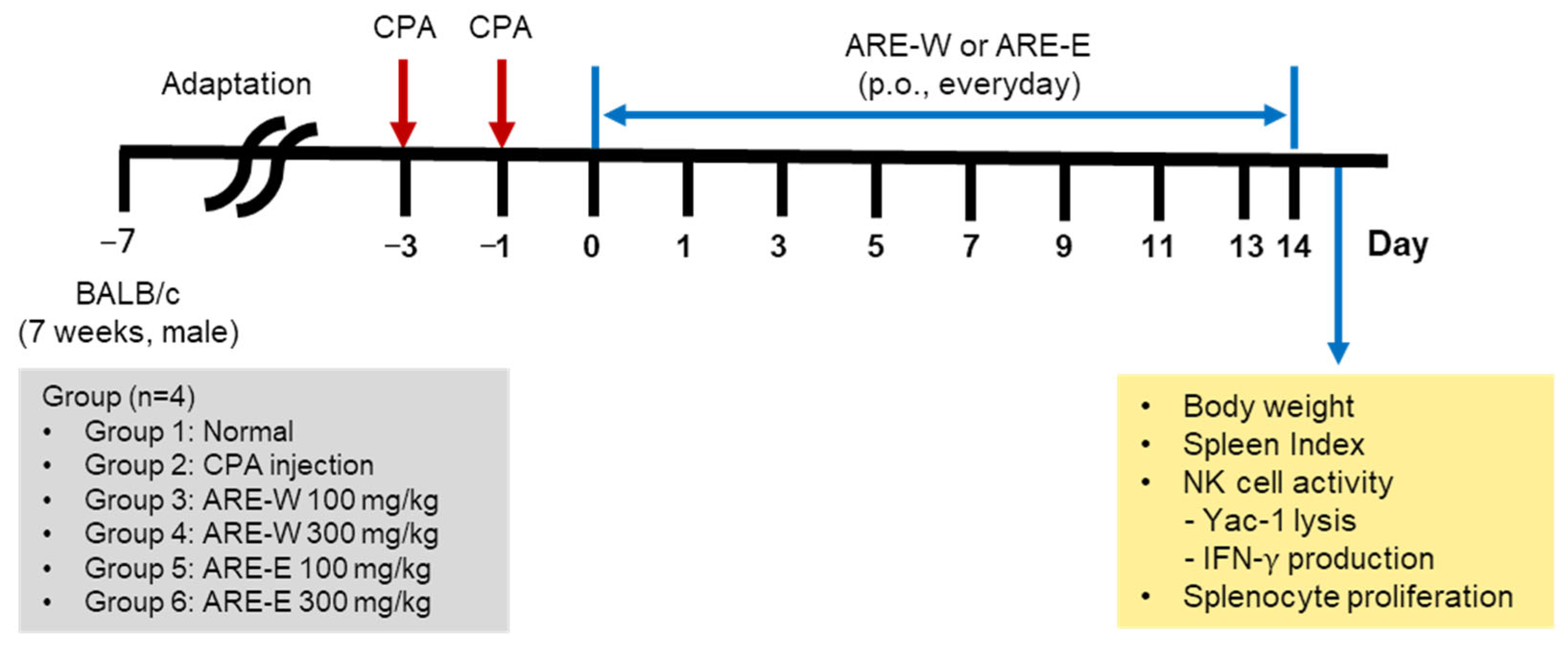
Disclaimer/Publisher’s Note: The statements, opinions and data contained in all publications are solely those of the individual author(s) and contributor(s) and not of MDPI and/or the editor(s). MDPI and/or the editor(s) disclaim responsibility for any injury to people or property resulting from any ideas, methods, instructions or products referred to in the content. |
© 2025 by the authors. Licensee MDPI, Basel, Switzerland. This article is an open access article distributed under the terms and conditions of the Creative Commons Attribution (CC BY) license (https://creativecommons.org/licenses/by/4.0/).
Share and Cite
Kim, S.J.; Kang, S.-I.; Lee, N.; Oh, J.M.; Kim, H.; Lee, M.-G.; Song, J.H.; Shin, M.-S. Immunoenhancing Effects of Jeju Agastache rugosa Extracts on NK Cell Activity and Lymphocyte Proliferation in Cyclophosphamide-Induced Immunosuppression. Pharmaceuticals 2025, 18, 1129. https://doi.org/10.3390/ph18081129
Kim SJ, Kang S-I, Lee N, Oh JM, Kim H, Lee M-G, Song JH, Shin M-S. Immunoenhancing Effects of Jeju Agastache rugosa Extracts on NK Cell Activity and Lymphocyte Proliferation in Cyclophosphamide-Induced Immunosuppression. Pharmaceuticals. 2025; 18(8):1129. https://doi.org/10.3390/ph18081129
Chicago/Turabian StyleKim, Sung Jin, Seong-Il Kang, Nari Lee, Jung Min Oh, Hiyoung Kim, Mi-Gi Lee, Ji Hoon Song, and Myoung-Sook Shin. 2025. "Immunoenhancing Effects of Jeju Agastache rugosa Extracts on NK Cell Activity and Lymphocyte Proliferation in Cyclophosphamide-Induced Immunosuppression" Pharmaceuticals 18, no. 8: 1129. https://doi.org/10.3390/ph18081129
APA StyleKim, S. J., Kang, S.-I., Lee, N., Oh, J. M., Kim, H., Lee, M.-G., Song, J. H., & Shin, M.-S. (2025). Immunoenhancing Effects of Jeju Agastache rugosa Extracts on NK Cell Activity and Lymphocyte Proliferation in Cyclophosphamide-Induced Immunosuppression. Pharmaceuticals, 18(8), 1129. https://doi.org/10.3390/ph18081129







